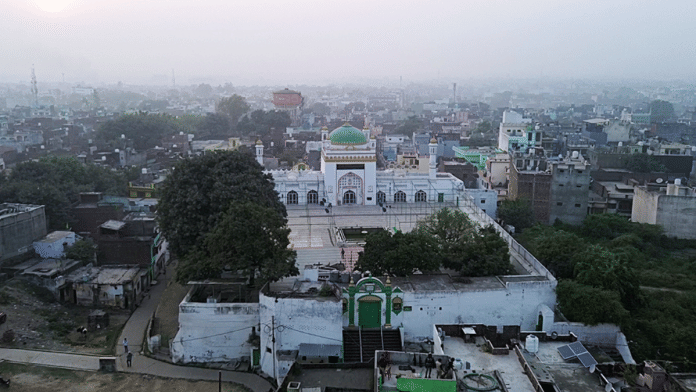New Delhi: A Sambhal court has issued notice seeking a response from the Muslim side after accepting a plea that contended that Mughal emperor Babar’s army, in 1526, partly demolished the Shri Har Har temple, giving way to a mosque at the site.
The petition was filed by advocate Harish Shankar Jain, who represents the Hindu side in the Gyanvapi mosque row as well.
On 19 November, judge Aditya Singh also ordered a survey of the Shahi Jama Masjid in Sambhal, Uttar Pradesh, on an application filed by eight different persons, including a lawyer and a mahant.
Notably, this is the third such case, after the Gyanvapi mosque row in Varanasi and the Shahi-Idgah case in Mathura, which follows a similar pattern. It sought an injunction to restrain the mosque’s management committee, including every person, supporter, worker, or office bearer, from interfering with the Archaeological Survey of India’s (ASI) functioning or creating obstacles for them.
The petitioners also sought the public’s right to access the property, in accordance with the provisions of the Ancient Monuments and Archaeological Sites and Remains Act, 1958, and the Ancient Monuments and Archaeological Sites and Remains Rules, 1959.
Importantly, advocate Ashwini Kumar Upadhyay and the Vishwa Bhadra Pujari Purohit Mahasangh have already challenged the constitutional validity of the Places of Worship (Special Provisions) Act of 1991 in connection with the Gyanvapi row. The 1991 Act bars the conversion of the religious character of a place of worship from how it existed on August 15, 1947. The only exception to this law was the Ram Janmabhoomi-Babri Masjid complex.
Also Read: Rioting mob, allegation of police firing. In Sambhal, 2 ‘truths’ linger after deadly clashes
What plea argues
Petitioners contended that a “centuries old” Shri Har Har temple dedicated to Lord Kalki, which exists in the heart of Sambhal city, is being used “forcibly and unlawfully” by the Jama Masjid Committee, Sambhal.
Contending that it is a protected monument notified on 22 December, 1920 under Section 3(3) of the Ancient Monuments Preservation Act, 1904, the petitioner said that this property was even declared as a monument of national importance, as is evidenced by the ASI website, besides being deemed to be a centrally protected monument.
Section 3 of the Act allows the Centre to, by notification in the official gazette, declare an ancient monument as a protected one.
Subsequently, Section 3(2) states that every such notification published under this provision shall be fixed at a “conspicuous place” on or near the monument, along with an intimation that any objection to the notification received by the Centre, within one month from the date when it was first put up, will be taken into consideration. Once this one-month period expires, the Centre, after considering objections, shall confirm or withdraw the notification.
Stating that the plaintiffs are idol worshippers and devotees of Lord Shiva and Vishnu, the petitioners contended that it is his right to visit and pay homage to the religious place of ‘Kalki Avtar’.
Asserting that the ASI hadn’t taken any step for the general public’s entry to give effect to Section 18 of the Ancient Monuments and Archaeological Sites and Remains Act, 1958, the petitioners argued that the ASI, the sole custodian of the property, had failed in its duty to make provisions for the public’s access to the property.
Section 18 deals with the right of access to protected monuments. “Subject to any rules made under this Act, the public shall have a right of access to any protected monument,” it says.
On 29 July, the petitioners sent an application to the ASI “demanding” public access to the property, but no action had been taken, the plea said.
Citing Babar’s autobiography Babarnama’s English translation by Annette Susannah Beveridge, the petitioners claimed that Babar came to Sambhal in July 1529. The petition also went on to reference reports composed under the ASI’s authority concerning surveys made between 1874 and 1876.
One such report quoted in the petition said, “The principal building in Sambhal is the Jami Masjid, which the Hindus claim to have been originally the temple of Hari Mandir.”
Similarly, another report said that the Muslims ascribed the building’s construction to the time of Babar and pointed to an inscription inside the masjid, which contains Babar’s name but which the Hindus assert to be forged.
Another report quoted in the plea states that the Muslims “took possession of the building by force; and that there was then a trial about the case in court before the judge of the district and that the Muhammadans gained the case mainly by means of the forged inscription” and by joining together and bearing false witness against Hindus, who were in the minority.
The petitioners argued that the public has a right to access the subject property according to the terms, conditions, or restrictions imposed by the ASI in accordance with Rule 5 of the 1959 Rules, which states that protected monuments, specified in the First Schedule, will remain open during specified hours while those that aren’t specified will remain open from sunrise to sunset.
Taking exception that the defendants have locked the doors, denying the ASI’s control over it and are misusing the property as a private one, the petitioners filed the case seeking the government agency’s control and management of the Jama Masjid.
(Edited by Tony Rai)
Also Read: Muslim men who died in Sambhal riots had stepped out for work, errands. ‘Police killed my young son’






